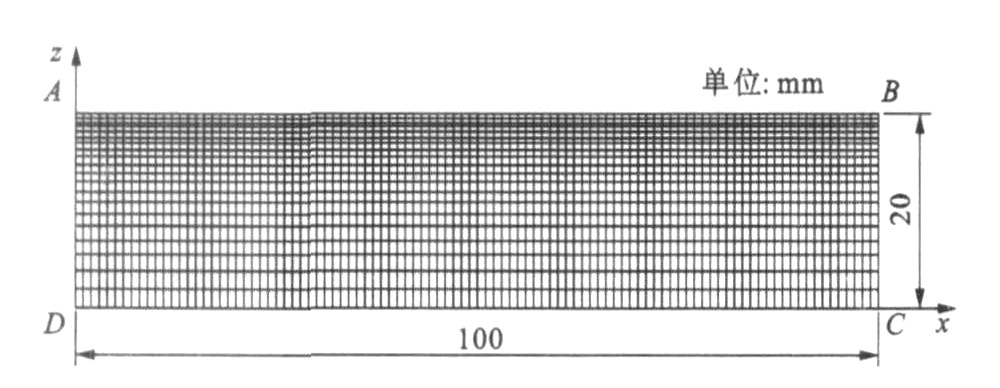Elastic finite element analysis model of coupling friction heat for wheel/rail
Article Text (Baidu Translation)
-
摘要: 基于伽辽金变分原理, 利用有限元方法, 建立了轮轨摩擦耦合热弹性有限元分析模型, 分析了轮轨摩擦热与钢轨接触区热膨胀位移、摩擦温度、应变和应力的关系。模型中温度场和位移场由耦合方程同时求解, 但没有考虑惯性项和材料阻尼的影响。分析结果表明: 耦合求解的温度场和位移场与非耦合求解的温度场和位移场的计算结果一致, 钢轨表面各点滑动位移的方向与车轮滑动方向一致, 垂向位移方向先负后正; 钢轨表面各节点进入接触区后, 温度快速上升, 但高温持续时间短; 在滑动方向上, 钢轨接触点先受压应变后受拉应变作用, 垂向受拉应变作用, 滑动方向压应力明显高于垂向压应力, 钢轨接触斑前后节点滑动方向应变符号相反; 垂向高正应变区主要集中分布在接触斑后半轴上, 最大剪应变与剪应力区在接触表层以下。Abstract: Based on Galerkin variation principle, an elastic finite element analysis model of coupling friction heat for wheel/rail was put forward, and the relations between wheel/rail friction heat and rail expanded displacement in touched area, wheel/rail frictional temperature, contact strain and stress.In the model, inertia term and material damping were ignored, temperature field and displacement field were synchronously solved by using coupling equations.Analysis result shows that coupling simulation values are identical with uncoupling computation values for temperature field and displacement field, the sliding displacement direction of rail surface contact node is identical with wheel sliding direction, and the vertical displacement is negative earlier then positive later; the temperature of rail surface contact node rises quickly in contact area, but the durative time of high temperature is very short, rail surface node experiences press strain early and pull strain later in sliding direction, experiences pull strain in vertical direction, the press stress in sliding direction is higher than in vertical direction, and the strain signs in the front and back of contact note are opposite; the vertical high strains are mostly distributed in the tail of half axle of contact area, and the maximum shear strain and stress appear under contact surface.
-
-
[1] 金学松, 张雪珊, 张剑, 等. 轮轨关系研究中的力学问题[J]. 机械强度, 2005, 27(4): 408-418. doi: 10.3321/j.issn:1001-9669.2005.04.002Jin Xue-song, Zhang Xue-shan, Zhang Jian, et al. Mechanicsin performance of wheel-rail[J]. Journal of MechanicalStrength, 2005, 27(4): 408-418. (in Chinese) doi: 10.3321/j.issn:1001-9669.2005.04.002 [2] 金学松, 张继业, 温泽峰, 等. 轮轨滚动接触疲劳现象分析[J]. 机械强度, 2002, 24(2): 250-257. doi: 10.3321/j.issn:1001-9669.2002.02.023Jin Xue-song, Zhang Ji-ye, Wen Ze-feng, et al. Overview ofphenomena of rolling contact fatigue of wheel/rail[J]. Jour-nal of Mechanical Strength, 2002, 24(2): 250-257. (in Chi-nese). doi: 10.3321/j.issn:1001-9669.2002.02.023 [3] Ramanan L, Krishna R K, Sriraman R, et al. Thermal-me-chanical finite element analysis of a rail wheel[J]. Interna-tional Journal of Mechanical Sciences, 1999, 41(4/5): 487-505. [4] 温泽峰, 金学松, 肖新标. 非稳态载荷对二维轮轨纯滚动接触应力和变形的影响[J]. 交通运输工程学报, 2006, 6(4): 14-19. doi: 10.3321/j.issn:1671-1637.2006.04.004Wen Ze-feng, Jin Xue-song, Xiao Xin-biao. Influence of non-steady state loading on two-di mensional wheel-rail pure roll-ing contact stresses and deformation[J]. Journal of Trafficand Transportation Engineering, 2006, 6(4): 14-19. (in Chinese) doi: 10.3321/j.issn:1671-1637.2006.04.004 [5] 张军, 吴昌华. 轮轨接触问题的弹塑性分析[J]. 铁道学报, 2000, 22(3): 16-21. doi: 10.3321/j.issn:1001-8360.2000.03.004Zhang Jun, Wu Chang-hua. Elasto-plastic analysis of wheel-rail contact problem[J]. Journal of the China Rail way Socie-ty, 2000, 22(3): 16-21. (in Chinese) doi: 10.3321/j.issn:1001-8360.2000.03.004 [6] 郭俊, 赵鑫, 金学松, 等. 全制动工况下轮轨热-机耦合效应的分析[J]. 摩擦学学报, 2006, 26(5): 489-493. doi: 10.3321/j.issn:1004-0595.2006.05.019Guo Jun, Zhao Xin, Jin Xue-song, et al. Analysis of wheel/rail thermo-mechanical coupling effects in sliding case[J]. Tribology, 2006, 26(5): 489-493. (in Chinese) doi: 10.3321/j.issn:1004-0595.2006.05.019 [7] Fischer F D, Werner E, Yan WY. Thermal stresses for fric-tional contact in wheel-rail systems[J]. Wear, 1997, 211(2): 156-163. doi: 10.1016/S0043-1648(97)00108-7 [8] 赵鑫, 温泽峰, 金学松. 轮轨滚动摩擦温升分析[J]. 摩擦学学报, 2005, 25(4): 358-363. doi: 10.3321/j.issn:1004-0595.2005.04.015Zhao Xin, Wen Ze-feng, Jin Xue-song. Coupling analysis ofwheel/rail frictional temperature[J]. Tribology, 2005, 25(4): 358-363. (in Chinese) doi: 10.3321/j.issn:1004-0595.2005.04.015 [9] 赵鑫, 温泽峰, 金学松. 表面不平顺对轮轨滚动摩擦温度场的影响[J]. 交通运输工程学报, 2005, 5(2): 19-22. doi: 10.3321/j.issn:1671-1637.2005.02.005Zhao Xin, Wen Ze-feng, Jin Xue-song. Uneven surface effecton temperature distribution of wheel and rail contact[J]. Journal of Traffic and Transportation Engineering, 2005, 5(2): 19-22. (in Chinese) doi: 10.3321/j.issn:1671-1637.2005.02.005 [10] Kennedy T C, Traiviratana S. Transient effects on heat con-ductionin sliding bodies[J]. Numerical Heat Transfer: PartA, 2005, 47(1): 57-77. [11] Kennedy T C, Plengsaard C, Harder R F. Transient heatpartition factor for a sliding railcar wheel[J]. Wear, 2006, 261(7/8): 932-936. [12] Ertz M, Knothe K. Acomparison of analytical and numericalmethods for the calculation of temperaturesin wheel/rail con-tact[J]. Wear, 2002, 253(3/4): 498-508. -





 下载:
下载:








